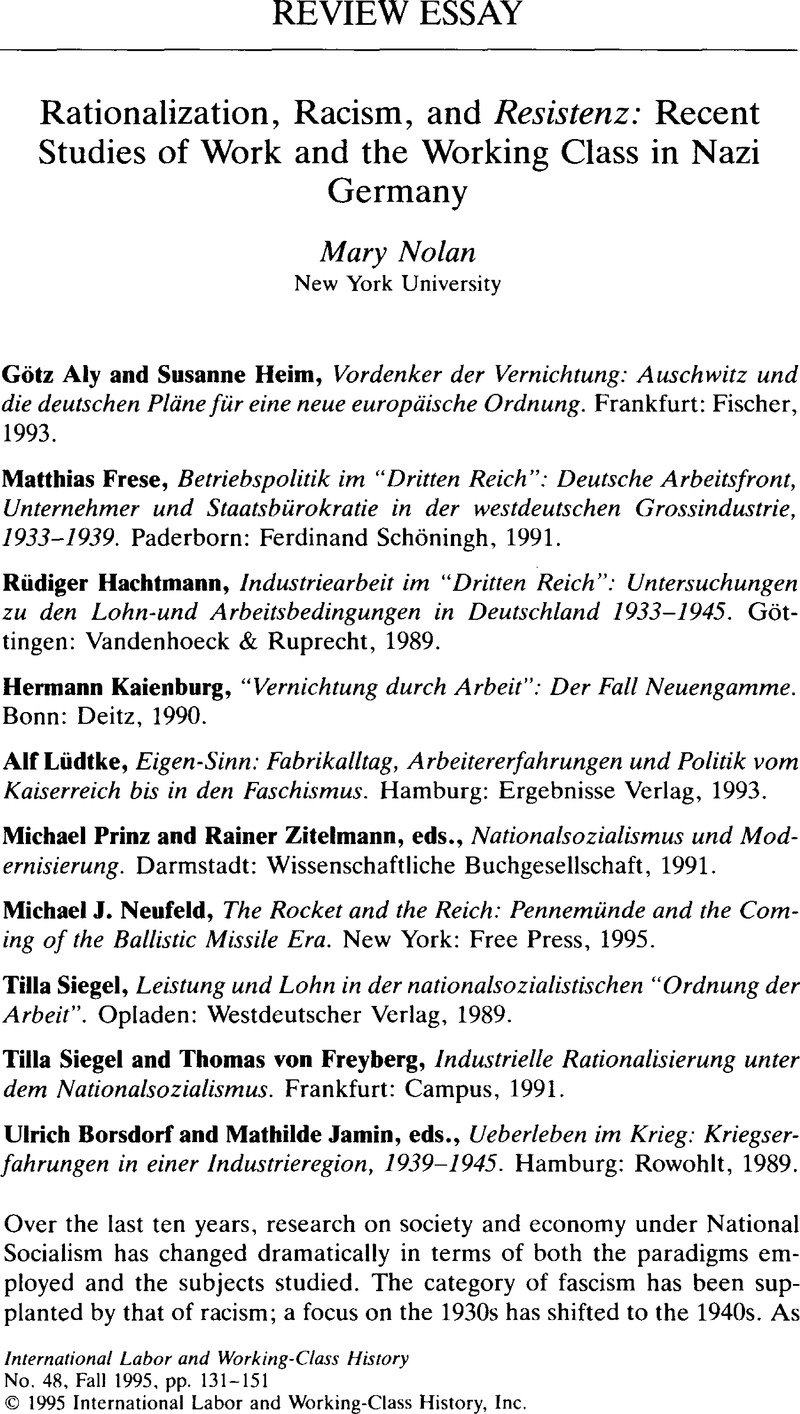Article contents
Rationalization, Racism, and Resistenz: Recent Studies of Work and the Working Class in Nazi Germany
Published online by Cambridge University Press: 16 December 2008
Abstract

- Type
- Review Essay
- Information
- Copyright
- Copyright © International Labor and Working-Class History, Inc. 1995
References
NOTES
1. This is the classic definition of Broszat, Martin, “Resistenz und Widerstand, Eine Zwischenbilanz des Forschungsprojekts ‘Widerstand und Verfolgung in Bayern 1933–1945,” in Nach Hitler: Der schwierige Umgang mit unserer Geschichte: Beiträge von Martin Borszat ed. Graml, Hermann and Henke, Klaus-Dietmar (Munich, 1987), 75–76.Google Scholar
2. Bellon, Bernard P., Mercedes in Peace and War: German Automobile Workers, 1903–1945 (New York, 1990);Google ScholarHayes, Peter, Industry and Ideology. IG Farben in the Nazi Era (New York, 1987);Google ScholarSachse, Carola, Siemens, der Nationalsozialismus und die moderne Familie (Hamburg, 1990).Google Scholar
3. Herbert, Ulrich, Fremdarbeiter: Politik und Praxis der “Ausländer Einsatzes” in der Kriegswirtschaft des Dritten Reiches (Berlin, 1986).Google Scholar Many of his arguments are contained in his History of Foreign Labor in Germany, 1880–1990 (Ann Arbor, 1990).Google Scholar
4. For a sampling of some of this new work and discussions of new historiographical and theoretical directions, see Reevaluating the Third Reich, ed. Caplan, Jane and Childers, Thomas (New York, 1993).Google Scholar
5. Kershaw, Ian, Popular Opinion and Political Dissent in the Third Reich: Bavaria 1933–1945 (Oxford, 1983);Google ScholarPeukert, Detlev, Inside Nazi Germany: Conformity, Opposition, and Racism in Everyday Life (New Haven, 1987).Google Scholar This was true of Mason's, TimothySozialpolitik im Dritten Reich: Arbeiterkiasse und Volksgemeinschaft (Opladen, 1977) but not of the revised English version, Social Policy in the Third Reich (Providence and Oxford, 1993).Google Scholar
6. Bartov, Omer, Hitler's Army: Soldiers, Nazis, and War in the Third Reich (New York, 1992);Google ScholarBrowning, Christopher R., Ordinary Men: Reserve Police Battalion 101 and the Final Solution in Poland (New York, 1992).Google Scholar
7. Schoenbaum, David, Hitler's Social Revolution (New York, 1966).Google Scholar
8. Mommsen, Hans, “Nationalsozialismus als vorgetäuschte Modernisierung,” in Der historische Ort des Nationalsozialismus, ed. Pehle, H. (Frankfurt, 1990), 31–46.Google Scholar
9. Peukert, Detlev, The Weimar Republic: Crisis of Classical Modernity (New York, 1992).Google Scholar
10. Smelser, Ronald, Robert Ley: Hitler's Labor Front Leader (New York, 1988);Google ScholarRabinbach, Anson, “The Aesthetics of Production in the Third Reich,” in International Fascism, ed. Mosse, George (Beverly Hills, Calif., 1979);Google ScholarSpohn, Wolfgang, “Betriebsgemeinschaft und innerbetriebliche Herrschaft,” in Angst, Belohnung, Zucht und Ordnung: Herrschaftsmechanismen im Nationalsozialismus, ed. Sachse, Carola et al. , (Opladen, 1982).Google Scholar
11. Lüdtke has published an English analysis of these letters. “The Appeal of Exterminating ‘Others’: German Workers and the Limits of Resistance,” Journal of Modern History 64 (Supplement, 12 1992):S46–S67.CrossRefGoogle Scholar
- 24
- Cited by




